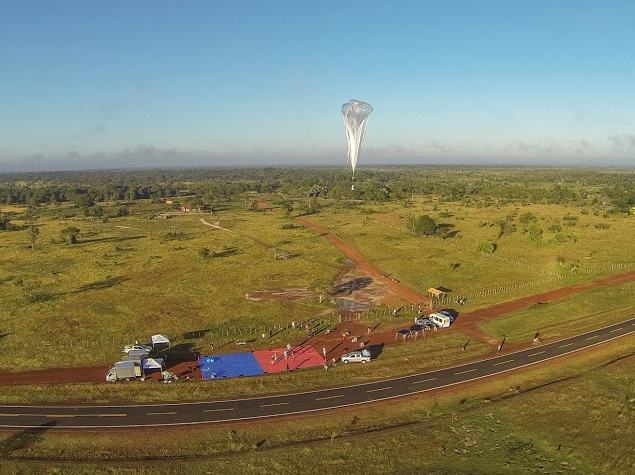- Home
- Internet
- Internet News
- Google Project Loon Internet Beaming Service Hits Speeds of 22MBps
Google Project Loon Internet Beaming Service Hits Speeds of 22MBps

Taking the project ahead, Google on Monday carried out a similar project where they launched a helium-filled balloon in the rural outskirts of Campo Major in Brazil. A local school, Linoca Gayoso, was connected to the Internet through it, for the first time in its existence.
Google's balloons fly free and out of eyesight, scavenging power from card table-sized solar panels that dangle below and gather enough charge in four hours to power them for a day as the balloons sail around the globe on the prevailing winds. Far below, ground stations with Internet capabilities are placed about 100 kilometers (60 miles) apart, and bounce signals up to the balloons. Each balloon would provide Internet service for an area twice the size of New York City, about 1,250 square kilometers (780 square miles), and terrain is not a challenge. The signals travel in the unlicensed spectrum, which means Google doesn't have to go through the onerous regulatory processes required for Internet providers using wireless communications networks or satellites.
(Also see: Project Loon: 7 things to know about Google's Internet-beaming balloon)
Google's Project Loon was invited to join in the local festivities during the celebrations of Festa Junina: a festival celebrating the winter solstice in Brazil where people send paper balloons skywards. The vast majority of people in the community have never had access to Internet services. They would sit in specific spots late in the evenings where they would receive weak signals on their mobile phones. The students in the school were 'able to get to the Internet from their classroom for the first time as they learned about world cultures.'
(Also See: Google may implement Internet-beaming balloons in India)
On the Project Loon account on Google+, the company said the test marked a few significant 'firsts' for Project Loon. The post, published Monday, reads, "Launching near the equator taught us to overcome more dramatic temperature profiles, dripping humidity and scorpions. And we tested LTE technology for the first time; this could enable us to provide an Internet signal directly to mobile phones, opening up more options for bringing Internet access to more place."
As far as the speeds go, over the last one year, since the launch of Project Loon, speeds offered by the service have improved a lot. Google recently gave Project Loon the ability to transmit data over the LTE spectrum, letting people connect directly to mobile phones without requiring an intermediate base station (in the case of Wi-Fi). The Project Loon balloons currently offer ten times better bandwidth, steer ten times better and stay up ten times longer than they did an year ago at the New Zealand test, according to Astro Teller, speaking to Wired.com. The balloons are currently capable of speeds of up to 22MBps (176Mbps) to the ground and 5MBps (40Mbps) to mobile devices.
For the latest tech news and reviews, follow Gadgets 360 on X, Facebook, WhatsApp, Threads and Google News. For the latest videos on gadgets and tech, subscribe to our YouTube channel. If you want to know everything about top influencers, follow our in-house Who'sThat360 on Instagram and YouTube.
Related Stories
- AI
- iPhone 16 Leaks
- Apple Vision Pro
- Oneplus 12
- iPhone 14
- Apple iPhone 15
- OnePlus Nord CE 3 Lite 5G
- iPhone 13
- Xiaomi 14 Pro
- Oppo Find N3
- Tecno Spark Go (2023)
- Realme V30
- Best Phones Under 25000
- Samsung Galaxy S24 Series
- Cryptocurrency
- iQoo 12
- Samsung Galaxy S24 Ultra
- Giottus
- Samsung Galaxy Z Flip 5
- Apple 'Scary Fast'
- Housefull 5
- GoPro Hero 12 Black Review
- Invincible Season 2
- JioGlass
- HD Ready TV
- Laptop Under 50000
- Smartwatch Under 10000
- Latest Mobile Phones
- Compare Phones
- HMD Pulse
- HMD Pulse+
- HMD Pulse Pro
- Realme Narzo 70x 5G
- Realme Narzo 70 5G
- Samsung Galaxy C55
- Blackview Hero 10
- Oppo K12
- Lenovo IdeaPad Pro 5i
- Asus ZenBook Duo 2024 (UX8406)
- Realme Pad 2 Wi-Fi
- Redmi Pad Pro
- boAt Storm Call 3
- Lava ProWatch Zn
- Samsung Samsung Neo QLED 8K Smart TV QN800D
- Samsung Neo QLED 4K Smart TV (QN90D)
- Sony PlayStation 5 Slim Digital Edition
- Sony PlayStation 5 Slim
- Lloyd 1.5 Ton 3 Star Inverter Split AC (GLS18I3FOSEW)
- Haier 1.5 Ton 3 Star Triple Inverter Split AC (HSU18K-PYSS3BN-INV)
















